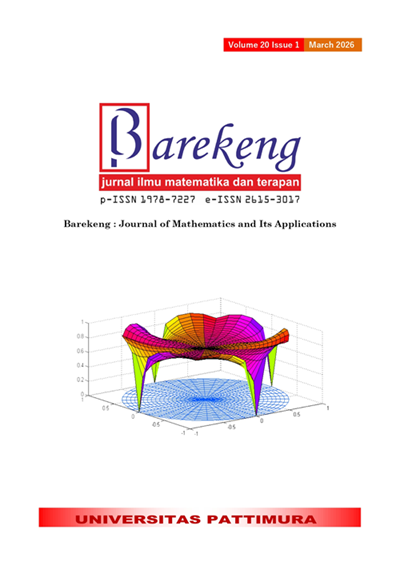BIVARIATE POISSON LOG-NORMAL REGRESSION MODELING ON THE NUMBER OF LEPROSY CASES IN INDONESIA
Abstract
Bivariate Poisson regression is a method for modeling two correlated count response variables. However, standard Poisson models often assume equidispersion, which is frequently violated in real-world data due to overdispersion. To address this issue, the Bivariate Poisson Log-Normal Regression (BPLNR) model is employed, which incorporates random effects to account for variability beyond that captured by the Poisson distribution. This study applies the BPLNR model to analyze the number of leprosy cases in Indonesia in 2021, categorized by the World Health Organization (WHO) into Paucibacillary (PB) and Multibacillary (MB). These two types are known to be correlated and exhibit overdispersion, rendering standard Bivariate Poisson models inadequate. This research contributes by applying BPLNR to leprosy data in Indonesia—an area that has been underexplored in prior studies, which largely employed univariate or standard Poisson approaches and ignored the correlation and overdispersion structure. Data were obtained from the 2021 Indonesian Health Profile and the Central Statistics Agency. Parameter estimation was conducted using Maximum Likelihood Estimation (MLE) with the Newton-Raphson algorithm, and hypothesis testing was performed using the Maximum Likelihood Ratio Test (MLRT). The results confirm that BPLNR effectively models the joint distribution of PB and MB cases while accounting for overdispersion. Key factors influencing both types of leprosy include population density, poverty rate, access to proper sanitation and drinking water, and availability of medical personnel and health facilities. A limitation of this study is the use of aggregate provincial-level data, which may obscure local variation and spatial effects. Future research could integrate spatial modeling techniques or individual-level data to enhance inference.
Downloads
References
A. Prahutama, S. Suparti, D. A. Munawaroh, and T. W. Utami, "MODELING BIVARIATE POISSON REGRESSION FOR MATERNAL AND INFANT MORTALITY IN CENTRAL JAVA," AIP Conf. Proc., vol. 2329, no. 1, 2021. doi: https://doi.org/10.1063/5.0042142
P. McCullagh and J. Nelder, GENERALIZED LINEAR MODELS, Routledge, 2019. doi: https://doi.org/10.1201/9780203753736
J. M. Hilbe, MODEL COUNT DATA, Cambridge University Press, 2014.
R. E. Walpole, R. H. Myers, S. L. Myers, and K. Ye, PROBABILITY AND STATISTICS FOR ENGINEERS AND SCIENTISTS, Prentice Hall, Macmillan, New York, 2016.
A. S. Ansari et al., "CLINICOBACTERIOLOGICAL EVALUATION OF LEPROSY PATIENTS WITH 1–5 SKIN LESIONS," Int. J. Mycobacteriology, vol. 9, no. 2, pp. 209–211, 2020.
World Health Organization, "GLOBAL LEPROSY (HANSEN DISEASE) UPDATE, 2021: MOVING TOWARDS INTERRUPTION OF TRANSMISSION," 2021. doi: https://doi.org/10.4103/ijmy.ijmy_7_20
S. C. Kurane and P. Dani, "CLINICAL AND SOCIODEMOGRAPHIC CHARACTERISTICS OF RECENTLY IDENTIFIED LEPROSY PATIENTS IN SANGLI DISTRICT OF MAHARASHTRA," Journal of Neonatal Surgery, vol. 14, no. 21s, 2025.
V. E. M. de Araújo, G. A. Veloso, L. R. F. S. Kerr, J. M. Pescarini, L. D. M. Cardoso, M. Naghavi, and D. C. Malta, "LEPROSY IN BRAZIL: AN ANALYSIS OF THE GLOBAL BURDEN OF DISEASE ESTIMATES BETWEEN 1990 AND 2019," Public Health, vol. 236, pp. 307–314, 2024. doi: https://doi.org/10.1016/j.puhe.2024.07.035
C. S. Smith et al., "MULTIDRUG THERAPY FOR LEPROSY: A GAME CHANGER ON THE PATH TO ELIMINATION," Lancet Infect. Dis., vol. 17, no. 9, pp. e293–e297, 2017. doi: https://doi.org/10.1016/S1473-3099(17)30418-8
I. Karunarathna, S. Rajapaksha, U. Ekanayake, and K. De Alvis, "FROM CLINICAL SYMPTOMS TO DIAGNOSIS: A GUIDE TO IDENTIFYING LEPROSY," 2024.
Y. Pieter and M. L. Grijsen, "PICTURING HEALTH: THE BURDEN OF LEPROSY IN EASTERN INDONESIA," Lancet, vol. 399, no. 10335, pp. 1588–1599, 2022. doi: https://doi.org/10.1016/S0140-6736(22)00699-7
S. Siswanti and Y. Wijayanti, "ENVIRONMENTAL RISK FACTORS FOR LEPROSY INCIDENCE," HIGEIA (J. Public Health Res. Dev.), vol. 2, no. 3, pp. 352–362, 2018.
I. Aisyah, A. V. W. Taufiq, and D. H. Apriliana, "DESCRIPTIVE EPIDEMIOLOGY OF HOUSEHOLD CONTACTS WITH LEPROSY PATIENTS IN LOMBOK BARAT AND LOMBOK TENGAH DISTRICTS, NUSA TENGGARA BARAT," in Proc. Int. Conf. Public Health, vol. 8, no. 1, pp. 152–166, Sep. 2023.
J. L. S. Siagian, S. Pangaribuan, and A. S. Ulimpa, "RISK FACTORS FOR LEPROSY AT BAINGKETE MAKBON DISTRICT SORONG REGENCY," Science Midwifery, vol. 10, no. 5, pp. 4211–4218, 2022. doi: https://doi.org/10.35335/midwifery.v10i5.985
E. E. Quilter et al., "PATIENTS WITH SKIN SMEAR POSITIVE LEPROSY IN BANGLADESH ARE THE MAIN RISK FACTOR FOR LEPROSY DEVELOPMENT: 21-YEAR FOLLOW-UP IN THE HOUSEHOLD CONTACT STUDY (COCOA)," PLoS Negl. Trop. Dis., vol. 14, no. 10, 2020. doi: https://doi.org/10.1371/journal.pntd.0008687
T. Dahiru et al., "LEPROSY CAPACITY IN HEALTH FACILITIES AND AMONG HEALTH WORKERS: A BASELINE SURVEY IN NIGERIA," Leprosy Rev., vol. 94, no. 4, pp. 317–331, 2023. doi: https://doi.org/10.47276/lr.94.4.317
S. Gustavsson, EVALUATION OF REGRESSION METHODS FOR LOG-NORMAL DATA, University of Gothenburg, Gothenburg, 2015.
S. H. Ong, W. J. Lee, and Y. C. Low, "A GENERAL METHOD OF COMPUTING MIXED POISSON PROBABILITIES BY MONTE CARLO SAMPLING," Math. Comput. Simul., vol. 170, pp. 98–106, 2020. doi: https://doi.org/10.1016/j.matcom.2019.09.003
M. L. Hazelton and L. Najim, "USING TRAFFIC ASSIGNMENT MODELS TO ASSIST BAYESIAN INFERENCE FOR ORIGIN–DESTINATION MATRICES," Transp. Res. Part B: Methodol., vol. 186, p. 103019, 2024. doi: https://doi.org/10.1016/j.trb.2024.103019
S. Nadarajah and J. Lyu, "NEW BIVARIATE AND MULTIVARIATE LOG-NORMAL DISTRIBUTIONS AS MODELS FOR INSURANCE DATA," Results Appl. Math., vol. 14, 2022. doi: https://doi.org/10.1016/j.rinam.2022.100246
G. Tzougas and A. P. di Cerchiara, "BIVARIATE MIXED POISSON REGRESSION MODELS WITH VARYING DISPERSION," North Am. Actuar. J., vol. 27, no. 2, pp. 211–241, 2023. doi: https://doi.org/10.1080/10920277.2021.1978850
S. Mardalena, J. T. D. Purnomo, and D. D. Prastyo, "BIVARIATE POISSON INVERSE GAUSSIAN REGRESSION MODEL WITH EXPOSURE VARIABLE: INFANT AND MATERNAL DEATH CASE STUDY," J. Phys.: Conf. Ser., vol. 1752, no. 1, 012016, 2021. doi: https://doi.org/10.1088/1742-6596/1752/1/012016
Copyright (c) 2025 Nasrah Sirajang, Salsabila Rahmadhani S, Siswanto Siswanto

This work is licensed under a Creative Commons Attribution-ShareAlike 4.0 International License.
Authors who publish with this Journal agree to the following terms:
- Author retain copyright and grant the journal right of first publication with the work simultaneously licensed under a creative commons attribution license that allow others to share the work within an acknowledgement of the work’s authorship and initial publication of this journal.
- Authors are able to enter into separate, additional contractual arrangement for the non-exclusive distribution of the journal’s published version of the work (e.g. acknowledgement of its initial publication in this journal).
- Authors are permitted and encouraged to post their work online (e.g. in institutional repositories or on their websites) prior to and during the submission process, as it can lead to productive exchanges, as well as earlier and greater citation of published works.






1.gif)



